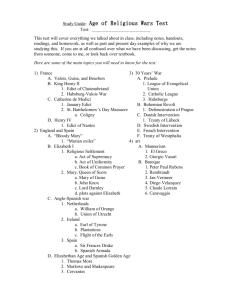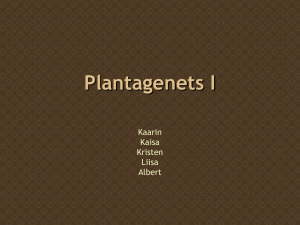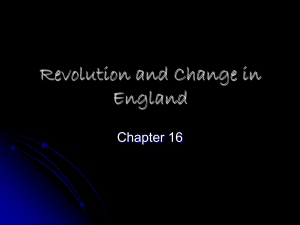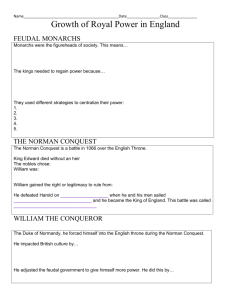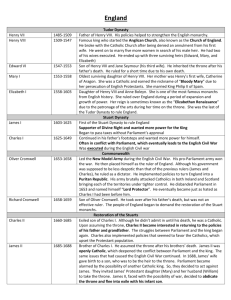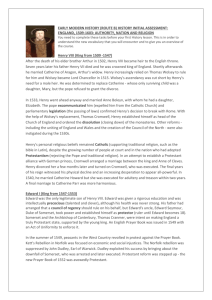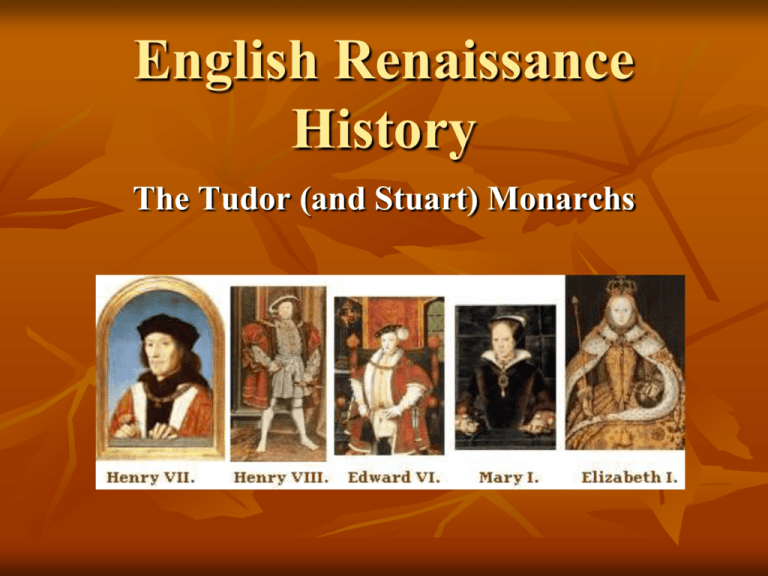
English Renaissance
History
The Tudor (and Stuart) Monarchs
Henry VII
Henry Tudor married
Elizabeth of York (daughter of
Edward IV).
Henry had defeated Richard III
at the Battle of Bosworth Field,
ending the Wars of the Roses.
Henry VII went on to forge
international relationships
through the marriages of his
children.
Second son of Henry VII
Arthur (1st son) Died: Spain and
England wanted to keep their alliance
So Henry married Catherine of
Aragon
Later he tried to annul this marriage
so he could marry Anne Boleyn.
Henry claimed that God punished
him by denying him a legitimate male
heir – in Leviticus, God does threaten
childlessness if a man marries his
brother’s widow…so Henry came to
see this marriage as cursed…
Henry VIII
I need a son. I have
been married for 20
years and my wife,
Catherine of Aragon
is too old to have any
more children. Who
will inherit my throne
when I die?
I spy an attractive lady
– in-waiting called Anne
Boleyn. If only I could
marry her instead. Will
the Pope give me a
divorce?
The Church is very rich.
I need money for my
luxurious court. If only I
could get my hands on it.
The new Protestant
ideas are spreading
in Germany.
Princes there are
reforming their
churches and
throwing out the
Catholic Church.
The Church takes
money out my
country in taxes to
help build St
Peter’s in Rome.
What do I get in
return?
Some people in England like the new
Protestant ideas. They believe that the
Bible should be in English not Latin.
Edward VI
He was the son of Henry VIII and Jane
Seymour - a Protestant who became king at
the age of 9.
The Church of England expanded while he
was king.
But he was sickly and died at the age of 16.
During his kingship, England was largely
under the rule of Edward’s council, which
included Thomas Seymour (the Duke of
Somerset)…
Jane Grey
Henry VIII’s grand-niece
Seymour wanted Lady Jane Grey as the
next queen, (Seymour’s son had married
Jane Grey.)
The rightful heir would have been Mary
(Edward’s oldest sister)
Jane was Protestant/ Mary was Catholic
So all the fundamental 16th century values
came into conflict – religion, patriotism, the
law, dynastic succession…
Edward opted for religion and plotted to get rid of Mary
(and Elizabeth, as he thought she would not go along w/
him)
Edward thought succession would go to the male
descendants of Mary Tudor (Henry VIII’s sister)
There were no male heirs at that time, but it was assumed
someone would have a son eventually…but then Edward’s
health went into rapid decline, and time was running out
On his deathbed, Edward changed his will to indicate that
Lady Jane Grey (and not her male heirs) should succeed
him
When Edward died, Jane became the queen, but Mary also
proclaimed herself the queen – when Jane’s army faltered,
the council abandoned her
When Mary recaptured the throne she had Seymour and
Jane executed (Jane was queen for 9 days)...
Mary I (Bloody Mary)
Mary was the daughter of Henry
VIII and Catharine of Aragon.
During her childhood, Mary was
persecuted by Henry when he
wanted to annul his marriage to her
mother.
As Queen she attempted to restore
Catholicism, and she married the
young Philip from Spain.
She also had more than 300
Protestants killed.
None of these actions was popular
with the now firmly entrenched
Protestant England
Mary died of ovarian/uterine
cancer at age 42.
Henry
VIII
Edward
VI
Mary I
Elizabeth
I
1509-1547
1547-1553
1553-1558
1558-1603
Protestant
Catholic
Protestant
Catholi
c
Prote
stant
Henry VIII’s Children
Elizabeth I
•
•
The red-haired daughter of
Henry VIII and Anne
Boleyn, she became
England’s greatest leader.
She kept control of England
by refusing to marry anyone
•
She kept religious wars
down, advanced
exploration, became a
patron of the arts, and
brought England to the
position of world power
with the defeat of the
Spanish Armada
Video
Mary (Stuart), Queen of Scots
Betrothed by her family to be the
Queen of France.
When Francois II died, she came
back to be Queen of Scotland.
Her return and marriages brought
religious conflict to Scotland
Mary ran to England hoping her
cousin would shelter her.
Instead Elizabeth imprisoned her for
19 years.
- As Henry VII of England's great-granddaughter, Mary was
next in line to the English throne, after Henry VIII's children.
- This again raised the succession issue…the Protestant
Elizabeth had a Catholic successor…and Mary became
“more” Catholic…
- w/ Mary as a symbol, rebellion began in the countryside
The Spanish Armada (Video)
The Pope entered into things, saying Elizabeth was a
heretic…so Elizabeth became a more hard-line Protestant
English Catholics turned to Spain for help (and Spain was
anti-Elizabeth as she supported piracy in the New World
and had aided the Dutch Revolt)
When proof of Mary’s treachery came to light, Elizabeth I
had her executed…Spain attacked, but the Armada
failed…
James I of England was
James VI of Scotland.
His mother was Mary
Queen of Scots, and at
Elizabeth I’s death,
James was named her
heir.
A Catholic, he was
known for the
authorization of the
King James Version of
the Bible, as well as for
being the “Wisest Fool in
Christendom”.
So became the first of
the Stuart Monarchs
JAMES I
ABSOLUTE
GOVERNMENT
Divine Rule
LIMITED
GOVERNMENT
A Constitution
LIMITS
GOVERNMENT
Government
Power
Laws
Taxation
Representative
Bodies
Sovereignty
Absolutism
Constitutionalism
Absolute
LIMITED
Judges decide by
PRECEDENT
Henry II
Absolutism
Constitutionalism
Government
Power
Absolute
LIMITED
Laws
Arbitrary
Common
Taxation
Representative
Bodies
Sovereignty
Magna Carta
(1215) “Great Charter”
The Holy Grail
of English Constitutionalism
A CONTRACT
Photo by One lucky guy
Photo by One lucky guy
Between the people
and their ruler
Absolutism
Constitutionalism
Government
Power
Absolute
LIMITED
Laws
Arbitrary
Common
Taxation
By Decree
By Consent
Representative
Bodies
Sovereignty
Parliament
Some rights reserved by UK Parliament
The Power of the Purse
KING
Parliament
Lords
(Bicameral)
Commons
Absolutism
Constitutionalism
Government
Power
Absolute
LIMITED
Laws
Arbitrary
Common
Taxation
By Decree
By Consent
Representative
Bodies
NO
YES
Sovereignty
Absolutism
Constitutionalism
Government
Power
Absolute
LIMITED
Laws
Arbitrary
Common
Taxation
By Decree
By Consent
Representative
Bodies
NO
YES
Sovereignty
Monarch
People
STUART ABSOLUTISM
James I Charles I
The Stuart Dynasty
INTERREGNUM
JI
1603-1625
CI
1625-1649
C II J II
RESTORATION
Charles II James II
CROMWELL
Believed Parliament was only around to give advice.
Charles 1 just didn’t call Parliament to session so he
didn’t have to listen to them.
Constitutional rule in theory, but Absolute rule in
practice.
• STUART ABSOLUTISM
• Divine Right
• Jamestown Colony
• Religious Uniformity
• STATE RELIGION
• Everyone must attend
Church of England services
• King James Bible
•
Authorized Version
• Second Son of James
• Throughout his reign there was
ongoing tension with Parliament
over money.
• Charles just cancelled Parliament
and decided he could raise money
on his own.
• This made him very unpopular.
• Unrest in Scotland forced him to
recall Parliament to raise funds
• In 1642, Charles tried to arrest 5
members of Parliament. This led
to Civil War
CAVALIERS/
Royalists
ROUNDHEADS/
Model Army
Supporters of the
King
Supporters of
Long Parliament
Led by Oliver
Cromwell
• Charles I beheaded
• END of Stuart
Absolutism
Now Who Would
Lead England:
Central Issues
1.
2.
3.
Enforcement of State Religion
King’s Power to Tax
WHO is Sovereign?
“Lord Protector”
Military Dictatorship
Strict
Rule
But he refused the
offer of the throne!
• Cromwell’s relationship with Parliament was a
troubled one
– Who was supreme?
– Which religions should be supported?
– Who controls the army?
– Who decides what to do with tax revenue?
• Cromwell died in 1658 and after his son failed
to be a successful leader, Parliament asked
Charles II to come back and be King.
“The Merry Monarch”
• Pursued a policy of political
tolerance and power-sharing
• Tried to formalize religious
toleration, but met resistance in
Parliament
• Dutch Wars were fought under
his reign, he signed an alliance
with France.
• His reign saw a rise in
colonization and trade through
the West Indies
• England became a sea power
• Left no legitimate heir so his
brother James II became King
Charles II’s Brother
• Catholic
• He appointed Catholics
to military and
university posts
• Unpopular with
• Parliament
• Protestants
• Declaration of
Indulgence- Restore
religious freedom to
Catholics
James II
• The birth of a son took away all hope from
Parliament that rule might pass to his
Protestant daughter after James died.
• Parliament urged William of Orange
(husband of that Protestant daughter) to
“save England from a Catholic takeover”
• Video
• William’s professional army and support from
Englanders caused James to flee to France
Run off by Parliament
Throne VACANTJames accepted exile
in France
No Bloodshed
Activity
• http://www.bl.uk/learning/histcitizen/uk/will3
/invaderoutline/events1688.html
• Was the seizure of the English throne by
William of Orange an invasion or a
revolution?
How does James feel he has been treated
badly?
1
2
3
4
How does William justify his actions?
1
2
3
4
WANTED
A monarch who will sit down,
shut up, and let Parliament take
care of governing.
Video
William and Mary signed the
English Bill of Rights, which
recognized Parliament as the
sovereign governing
authority in England.
1) What grievances did Parliament have against James II?
2) What rights did the English declare for themselves?
3) What groups were given special privileges in this
document?
4) What comparisons can you make between this
document and the U.S. Bill of Rights?
5) Where does sovereignty reside?
http://www.yale.edu/lawweb/avalon/england.htm
Grievances
•
•
•
•
PAPIST
Taxation without consent
Standing army in a time of peace
Allowed papists to be armed and disarmed
Protestants (a.k.a., “Good Citizens”)
• Partial, corrupt, and unqualified jurors
• Excessive fines and bails
• Free elections
Declaration of Rights
• PARLIAMENTARY SUPREMACY
• Free elections of Parliament
• Protestants get to have “arms for their
defense… suitable to their conditions as
allowed by law”
• Petition the government
• Qualified jurors (freeholders)
• Frequent Parliaments
Commonalities w/ Bill of Rights
•
•
•
•
•
•
Cruel and unusual punishments
Excessive bails
Right to bear arms
Quartering troops
Freedom of Speech
“Jury of… peers”
REVIEW
Absolutism
MONARCH(S)
KEY EVENTS / ACHIEVEMENTS
JAMES I
King James Bible (Authorized Version)
Jamestown Colony
Divine Right of Kings
Enforced Religious Uniformity
Short Parliament / Long Parliament
English Civil War
BEHEADED
(1603-1625)
CHARLES I
(1625-1649)
INTERREGNUM
(Cromwell’s Dictatorship)
Restorat
CHARLES II
The “Merry Monarch”
Test Acts (No Catholics in Office)
JAMES II
Catholic
10-Minute Quick Write
You will be given 5 minutes to look through your
notes and outline your answer. Do not start
writing until I say “go”.
• In England, how did religious and
political conflict shape the reign
of the Stuart monarchs (16031688)?


